So, I got a fake Shaligram. But don’t be indignant on my behalf, it was on purpose.
One of the most pervasive fears many Shaligram devotees (or would-be devotees) have is ordering a Shaligram online, typically from an established seller, and receiving a fake stone. But unfortunately, due to both profiteering and scarcity, it’s not an uncommon problem.
Ordering Shaligrams over the internet is a contentious topic among numerous practitioner communities for a variety of reasons. This is mainly because finding one’s own Shaligrams on pilgrimage is the ultimate religious ideal. But, sadly, a great many people are unable to reach the high Himalayas in order to do so (for economic, health, and political access reasons). As a result, choices are often limited in terms of getting a Shaligram in other ways. If possible, the second option for many devotees would be to receive one as a gift or acquire one from a temple collection. This is because placing monetary value on sacred stones is explicitly forbidden in many Hindu traditions and, for that reason, Shaligrams are never supposed to be bought or sold (to do so is a karmic sin). Barring that, getting one from another devotee in exchange for some other spiritual object or service is also considered to be an acceptable form of Shaligram mobility. The last resort however, when all other previous avenues have been exhausted, is then to look online, where any number of sellers and shops exist (from Amazon, to Ebay, to Etsy) to cater specifically to Shaligram practitioner’s needs.
Unfortunately, many of these sellers are less than reputable when it comes to the origin, quality, and authenticity of their stones. Aside from that, even trusted sellers tend to price their ritual Shaligrams out of reach of the average devotee and can sometimes ask as much as several thousand dollars for a particularly rare or unusual deity. “Average” Shaligrams are then still relatively quite expensive, at several hundred dollars apiece plus shipping. Finally, very small or low quality Shaligrams round out the bottom of the list at roughly between $50 and $100 depending on the clarity of their chakras (ammonite shell spirals) and overall appearance of the stone. The price, in these cases, is therefore supposed to represent compensation for the seller’s travel, time, and trouble in getting the stone from Mustang and not, as might be the more pessimistic interpretation, the cost of the stone itself.
Even so, stories of receiving fake stones abound.
There are generally three well-known ways to fake a Shaligram. The first involves taking broken pieces of a real Shaligram and gluing them together in a kind of facsimile of a whole, unblemished, stone. This method is also sometimes used to add additional chakras to otherwise “unimpressive” Shaligrams or to repair a damaged ritual stone and sell it off rather than return it to the Kali Gandaki or to the care of a temple (as is the typical tradition). For the most part, glued piecemeal stones are reasonably easy to spot by their surface seams and cleavages but such things can be easily hidden in webpage photos for the unsuspecting buyer who cannot otherwise inspect the Shaligram on their own time.
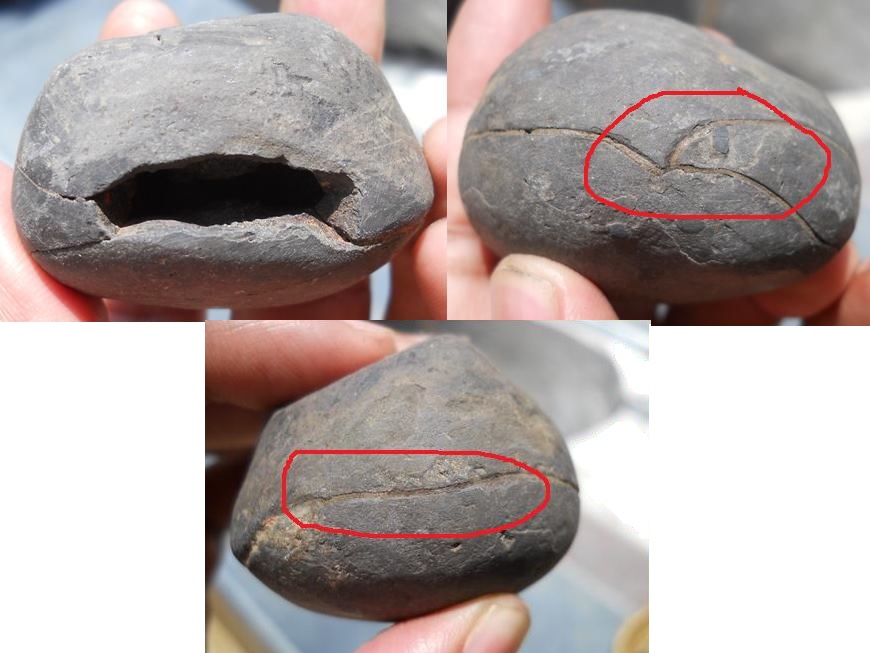
The second, and far more popular, way of faking a Shaligram is to mold or fabricate an entirely new stone out of M-Seal industrial epoxy or concrete. M-Seal versions of Shaligrams look the best in photos largely due to the smooth, shiny, black exterior of the resulting plastic nodules, which superficially resemble the appearance of a real Shaligram just out of the river or just following ritual bathing (abishek). Some sellers will even take this further by attempting to press or stamp “chakra” shapes into the false stone and I have seen some impressive instances of such sculpted Shaligrams. Sadly, many of these fake stones tend to fool even the relatively practiced eye of long-time devotees, depending on the skill of the fabricator. This is because, while a significant number of devotees have tremendous experience with sacred objects, not many have much in the way of familiarity with invertebrate fossils. Meaning, they aren’t always quite so savvy in recognizing imprinted shapes that wouldn’t be found in nature and thus, which couldn’t be formed by a petrified ammonite.
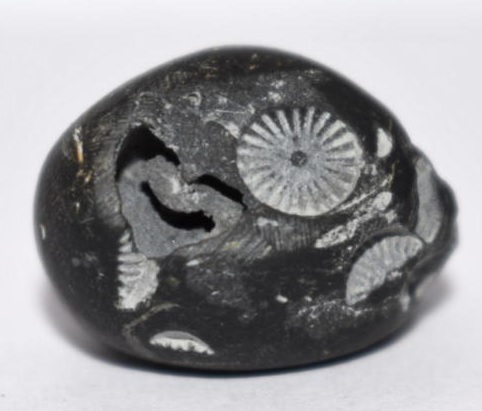
Recognizing these kinds of faked Shaligrams, unfortunately, often requires physical handling; which is another reason why being in the actual presence of a Shaligram is so vital to receiving one. Not just from a spiritual sense, but a practical one as well. M-Seal Shaligrams tend to feel “plastic-y” to the touch and are far lighter than a real stone would be. Additionally, if scratched with a fingernail or sharp implement, they will indent and furrow in the way that epoxy does when damaged, rather than powdering like black slate. Concrete Shaligrams work similarly, but in that scratching them reveals their underlying sandy composition or simply chips the paint (since most concrete can’t be made to look like smooth black shale when dry). They also tend to fracture more readily than either M-Seal or a real stone and will often fall apart with little more than a firm tap.
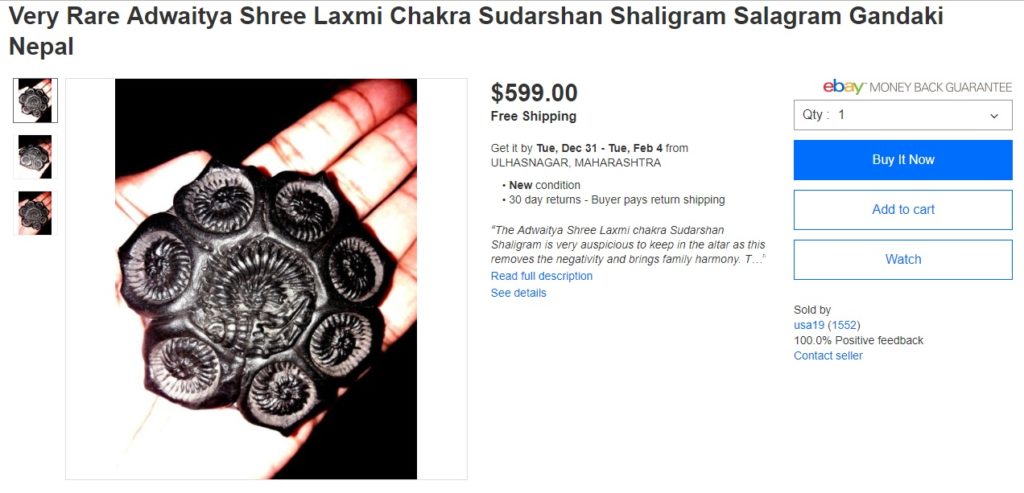
Finally, one of the more bizarre ways to fake a Shaligram is to simply substitute another fossil in for the Kali Gandaki ammonite. I’ve seen trilobites advertised as “Ganesh Shaligrams,” other kinds of ammonites obviously from elsewhere in the world claimed to be from Nepal, as well as fossilized plants, crinoids, and insects. As I have discussed previously, none of these fossils are Shaligram owing to the fact that they have not undergone death and re-formation in the sacred landscape of Muktikshetra and have not been born from the waters of the sacred river (one of the key parts of the process to becoming Shaligram).

As a side note, this problem has resulted in a variety of methods for determining the authenticity of a Shaligram; involving everything from keeping the stone in a pile of rice (to see if the rice increases or decreases), to spinning them with the tip of a finger, to scratching them with gold, to seeing if they float in water (which a real Shaligram wouldn’t do, but then again, neither would a concrete one.)
But again, most of this relies on general ignorance of geological and fossil processes and anticipates that people who are buying Shaligrams online are not otherwise in contact with these types of sacred stones often enough such that they would readily be able to recognize a fake one.
My new fake Shaligram is of the second variety: an M-Seal nodule smoothed and shaped to look like a real stone. Mine, unfortunately, does not have any chakra impressions or other “markings” and probably wouldn’t be broadly appealing to a devotee looking for a puja-worthy stone anyway but my reason for getting it has nothing to do with veneration. Rather, I’ve long wanted one so that, whenever I am giving talks on Shaligrams or conducting workshops on identification, I can use it as an educational example for what to be wary of. It is also the reason it was given to me by a devotee I’ve known for a long time and whom I have worked with previously in combating the spread of false Shaligrams. In the end, I would actually like to build a collection of such manufactured Shaligrams for this purpose.
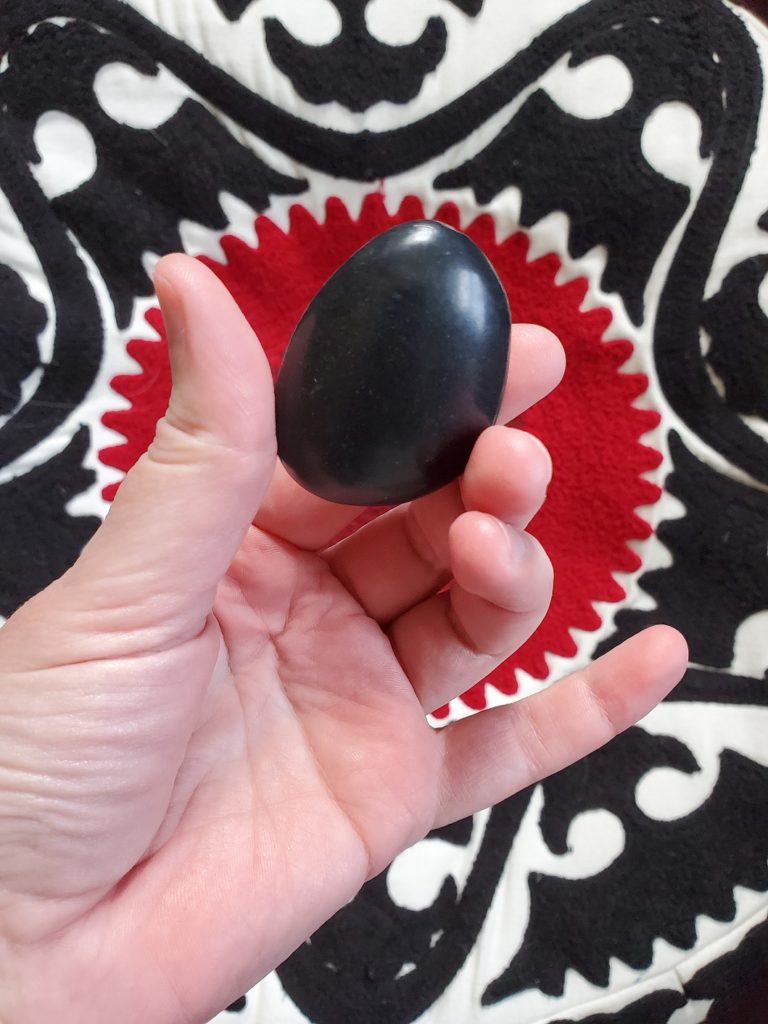
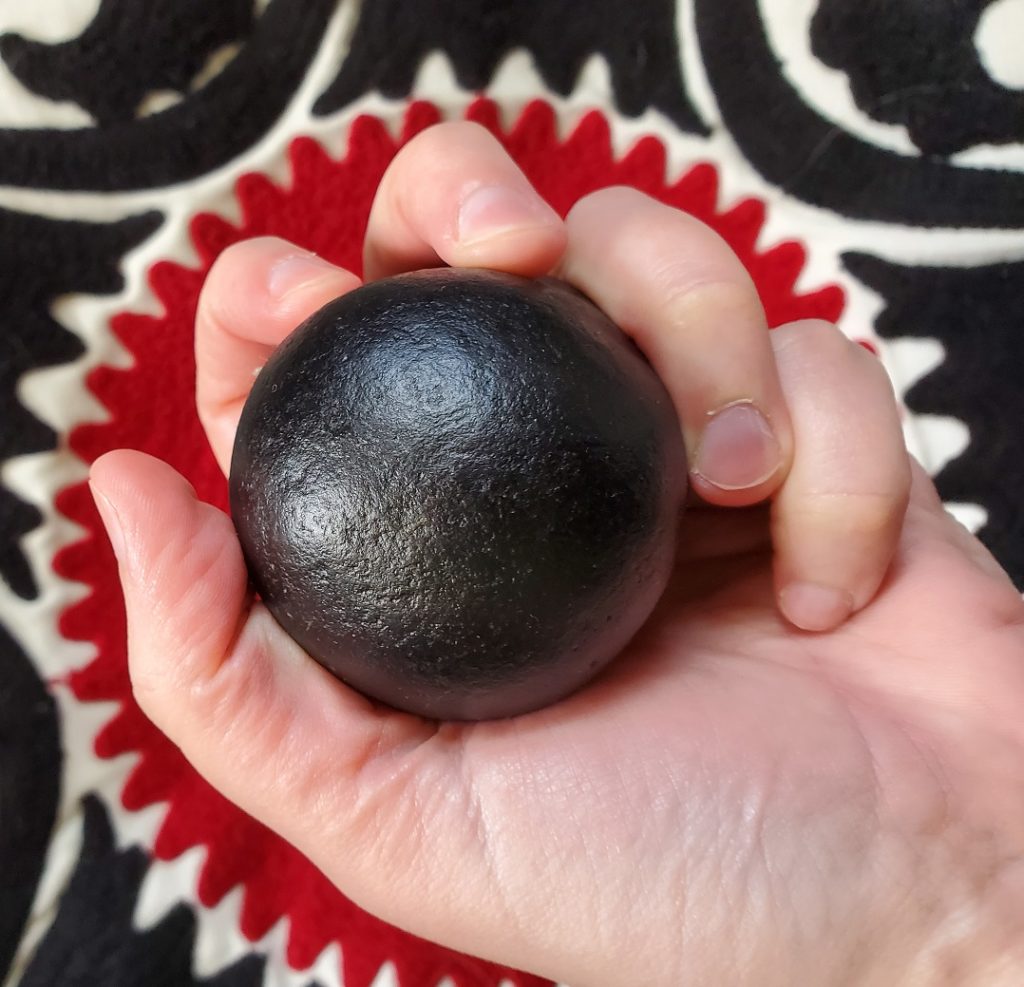
(Would you be able to tell the difference from a photo if I hadn’t already told you which one was genuine?)
Thus far, my collection of gaffes includes a black trilobite, a broken Shaligram re-glued, and now, an M-Seal imitation. At some point, I would then like to also acquire other M-Seal or concrete Shaligrams with cut or tooled markings or one that has been molded wholesale from an impression. I am, however, not keen on spending the hundreds of dollars many sellers ask for such obvious (to me) fakes and I can only imagine what a grant application would look like that had a provision in it for paying out that kind of expense on what amounts to chunks of plastic and cement. I’m also not especially enthusiastic about attempting to fake one myself. I’m confident my sculpting skills are up to par in this regard but I’m not entirely sure this is the kind of relationship I really want to cultivate with my research at this given moment.
In the end, the practice of falsifying sacred stones is an opportunistic one. Like many instances of people seeking to profit from the misfortunes of others, fake Shaligram sales are driven by the increasing inaccessibility of Mustang (for pilgrimage) as well as the challenges of ritual-object practice in the Diaspora; where communities have less in the way of established home temples, gurus, or Shaligram specialists. As a result, the dilemma many young Shaligram practitioners face is to potentially receive a fake stone (while losing a large amount of money in doing so) versus never being able to have a Shaligram stone at all. And if the latter continually comes to pass, many fear that the tradition itself will be in danger of disappearing as sons and daughters no longer learn the stories, pujas, and mantras from their elders or just never encounter a real Shaligram in their lives.
On a personal note, I’m often asked to identify new Shaligrams and I hate having to tell someone that a stone is fake. In many cases I can, thankfully, do so from an image before the item has been purchased but more often than not, it involves questions someone has regarding a stone they’ve had (and sometimes worshipped with) for years. Ultimately, faking fossils has a pretty long and gory history all over the world (both paleo-anthropology and paleontology, for example, have some pretty spectacular instances of this) but now we can add another version to the concerning line-up of spiritual fossil fakery. Not in the better-known Creationist sense this time, where the fossil record is intentionally altered and re-interpreted to fit fundamentalist Biblical narratives, but as a way of subverting darshan (the ritual viewing of and interacting with deities in many South Asian religions) into less a relationship with the material Divine and more a commodified form of tourist religion that blurs the lines between “icon” and “souvenir” even more so than usual.
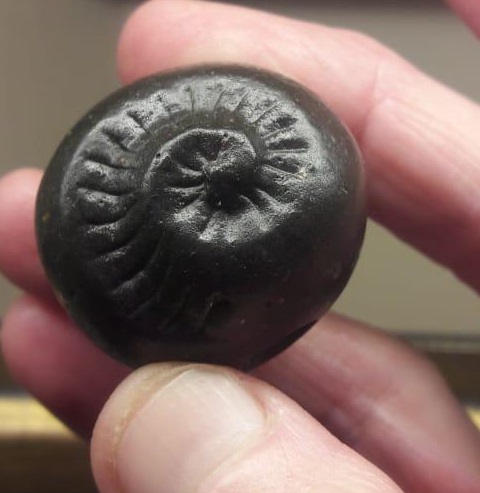
Buyer beware, indeed.

I would love to send you a some pictures of a couple unique Shaligrams I have to get your opinion on their features. Is there an email I can send to? I’m sure you’re quite busy so if not I understand!
Jai Gadai
Hi! I’d be happy to tell you what I can. My general email is prolegomenon (at) gmail.com.
A well formed chakra – but carefully cut away from its rock bed – is it fit for worship? The bottom part of the piece shows chisel marks
That’s not usually a problem and many cut marks can be smoothed off with time. The important part that the texts generally focus on is that the Shaligram itself is not broken. If the shila is whole with a well-formed chakra, it is perfectly fine. — HW
What is the sides and back of the salagram is covered with some black stuff which goes away on scraping. Would that be okay to worship
Yes, that would still be fine. If the black paint can be cleaned off and the Shaligram is unbroken, it is still okay. Sadly, sellers sometimes think that only very black Shaligrams are desirable but grey-blue/grey Shaligrams are quite common. In the Puranas, they are called “sky-colored.” — HW
hi, i am trying to purchae orgiginal saligram, unfortunately , i am getting confused whether its original or fake.. few googled sites are shaligram.com rudragems.com..
please let me know where i will get original Lakshmi Naryan saligram.. if possible provide their contact detials to thiyagsn at gmail com.
Unfortunately, I don’t work directly with any sellers so I have no way of knowing if the Shaligrams they offer are genuine or not. If anyone here has suggestions, I invite them to post them! — HW
Thanks for your elaborated discussion… I will get touched with you….
Thanks for your elaborated discussion… I will get touched with you…. The last picture sent by you is a FAKE SALIGRAM
All of the Shaligrams in this post, except for one, are fake Shaligrams.
I obtained 2 Saligrams recently after the scratch test.
After pouring water and worshipping, I kept it in the copper box. Next day when I opened the box I saw that the Saligramas are like sweating . Moisture around it. The Tulasi on it is also getting dampened like fungus.
What may be the reason.
Be sure to dry the shilas very well after washing. Some Shaligrams actually take in water and drink it up. So if they are then placed in a sealed box, the air will get very humid inside.
I’m from India and have been reading the posts in your blog. Its truly a blessing for all the people who wish to possess the sacred stone. The information you have shared here is hard to find elsewhere. The fact that you still help people with information is truly admirable.
I’m interested in collecting some Shaligrams from Kali Gandaki, though I’m not sure when I would get a chance to travel. The basic things that I need to understand are the things like:
– permits to travel to Kagbeni, Upper Mustang,
– restrictions on collecting Shaligrams(is there a restriction on size, weight, number of Shaligrams that a person is allowed to collect, etc.)
– any other information that might help in bringing Shaligrams from Nepal to India without hiccups.
Would a travel agent from Nepal provide the latest and accurate information for the above questions?
I cover most of these questions in the post called “A Guide to Getting There,” but I will answer what I can here:
1. The permits to travel to Mustang are available at permit offices in Kathmandu and in Pokhara.
2. There are currently no restrictions on collecting Shaligrams in the Kali Gandaki. But you might have to limit yourself to only a few since the weight can be an issue on the plane.
3. If this is your first time traveling to Mustang, I highly advise going through a Nepali trekking agency. They can ensure you get the correct permits and all the local information for traveling in the high Himalayas. Groups like Alliance Trekking, for example, do this often for Shaligram pilgrims.
I hope that helps! — HW